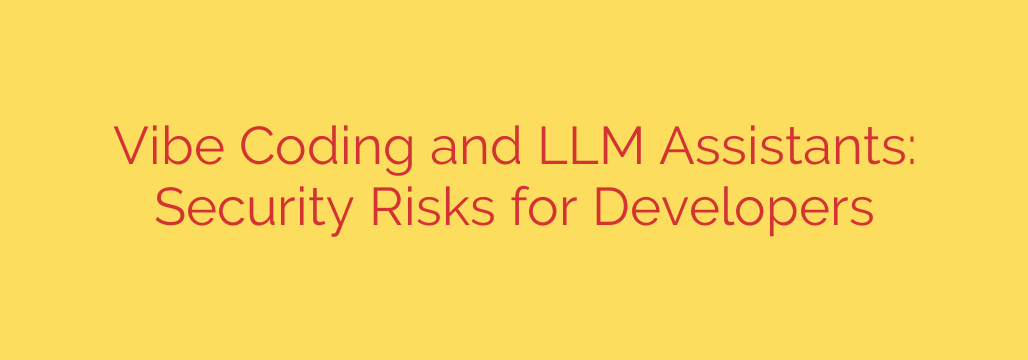
“Vibe Coding” with AI: The Hidden Security Risks Lurking in Your Code
AI-powered coding assistants like GitHub Copilot and ChatGPT are revolutionizing software development. They promise unprecedented speed, suggesting entire blocks of code in an instant and helping developers power through complex tasks. But this convenience comes with a hidden cost—a new and subtle class of security risks that can leave applications dangerously exposed.
As developers increasingly rely on these Large Language Models (LLMs), a practice known as “vibe coding” is on the rise. This is the tendency to accept AI-generated code because it feels right or looks like it works, without performing the rigorous security validation required for production-grade software. This blind trust can introduce critical vulnerabilities that are easy to miss but devastating if exploited.
Understanding these risks is the first step toward using AI assistants safely and effectively.
The Core Problem: AI’s Training Data is Flawed
LLMs learn by analyzing vast quantities of existing code, most of it sourced from public repositories like GitHub. The problem? This data contains decades of code written with varying levels of quality and security awareness. The AI learns from everything—the good, the bad, and the outright vulnerable.
As a result, an LLM can confidently suggest code snippets that contain long-since-deprecated functions, insecure patterns, or common vulnerabilities simply because it has seen them thousands of times in its training data. The code may be functionally correct for a given task, but it can simultaneously harbor serious security flaws.
Top Security Vulnerabilities Introduced by AI Assistants
Relying on AI-generated code without proper scrutiny can open the door to several classic and modern vulnerabilities. Here are the most critical ones to watch out for.
1. Insecure and Outdated Code Suggestions
One of the most common risks is the suggestion of code that uses outdated libraries or insecure programming practices.
- SQL Injection (SQLi): An AI assistant might suggest constructing a database query by concatenating strings with user input—a classic recipe for SQL injection. While a seasoned developer might spot this instantly, someone working quickly or in an unfamiliar language might not.
- Use of Weak Cryptography: The model may suggest using outdated and broken hashing algorithms like MD5 or SHA1 for password storage, simply because these examples are prevalent in older training data.
- Cross-Site Scripting (XSS): LLMs can generate front-end code that fails to properly sanitize user input before rendering it on a page, creating a perfect pathway for XSS attacks.
The AI has no inherent understanding of security best practices. It only knows patterns. If an insecure pattern is common, it is likely to be replicated.
2. Accidental Exposure of Secrets
Developers often use placeholder keys, tokens, and passwords in their code during testing. When this code is uploaded to public repositories, it becomes part of the AI’s training data. Consequently, LLM assistants have been observed suggesting code that includes hardcoded credentials. While these are usually fake, they can also suggest real-world formats that tempt a developer to simply replace the placeholder with a real secret and commit it.
Even more dangerously, if your own private code is inadvertently used to train a model, the AI could leak proprietary logic or sensitive information in its suggestions to other users.
3. Subtle Logical Flaws
Not all vulnerabilities are as obvious as an SQL injection flaw. AI can generate code that is syntactically perfect and seems to work under normal conditions but contains subtle logical errors that can be exploited.
These might include race conditions, improper error handling that reveals sensitive system information, or authorization checks that are incomplete. These bugs are particularly insidious because they often pass basic functional tests, only revealing their weaknesses under specific attack scenarios. The developer, trusting the AI’s output, may not think to test for these edge cases.
Actionable Security Best Practices for AI-Assisted Development
AI coding assistants are powerful tools, but they must be treated as what they are: highly advanced autocompletion engines, not infallible expert programmers. The ultimate responsibility for code quality and security always rests with the human developer.
Here are essential steps to mitigate the risks of “vibe coding”:
Treat AI Suggestions as Untrusted Input: This is the most important mindset shift. Every line of code suggested by an AI should be treated with the same skepticism you would apply to a code snippet copied from an unvetted forum post. Always review, understand, and validate AI-generated code before accepting it.
Run Static Application Security Testing (SAST): Integrate SAST tools directly into your IDE and CI/CD pipeline. These automated scanners are excellent at catching common vulnerabilities like SQL injection, the use of insecure functions, and hardcoded secrets that might be present in AI-generated code.
Prioritize Dependency Scanning: If an AI suggests adding a new library or dependency, immediately check it for known vulnerabilities. Use tools like Dependabot or Snyk to automatically scan your project’s dependencies and alert you to insecure versions.
Never Use AI for Sensitive Logic: Avoid using AI assistants to generate code for critical security functions like authentication, authorization, or cryptography. These areas require meticulous, expert-level implementation that is beyond the current capabilities of LLMs.
Implement Pre-Commit Hooks: Configure pre-commit hooks that automatically scan for hardcoded secrets before any code can be committed to your repository. This provides a crucial safety net against accidentally leaking credentials.
Conclusion: The Developer is the Final Line of Defense
AI coding assistants are here to stay, and their capabilities will only continue to grow. They offer immense potential for boosting productivity and helping developers learn. However, embracing them without acknowledging the associated risks is a recipe for disaster.
The era of “vibe coding”—of accepting code based on a gut feeling—must be replaced by a culture of vigilant verification. By treating AI as a junior partner that requires constant supervision, developers can harness its power without compromising the security and integrity of their applications. The tool has changed, but the fundamental principles of secure development have not.
Source: https://www.kaspersky.com/blog/vibe-coding-2025-risks/54584/








